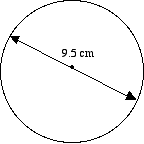|
Q1:
|
A circle has a radius of 9 cm.
What is its diameter?
|
A. 3 cm
B. 18 cm
C. 6 cm
D. 4.5 cm |
Answer 1:
|
|
|
Q2:
|
Which of the following can be used as approximations for pi?
|
A. 
B. 3.1
C. 3.14
D. all of the above |
Answer 2:
|
|
|
Q3:
|
If the diameter of a circle is 12 metres, what is the radius? |
A. 24 m
B. 6 m
C. 36 m
D. 6 cm |
Answer 3:
|
|
|
Q4:
|
What is the radius of the circle?

|
A. 3.75 cm
B. 28.5 cm
C. 4.75 cm
D. 19 cm |
Answer 4:
|
|
|
Q5:
|
What is the circumference of the circle above?
Use π = 3.1
Remember:
Circumference = pi x diameter
|
A. 29.45 cm
B. 24.8 m
C. 32 m
D. 99.2 m |
Answer 5:
|
|
|
Q6:
|
What is the area of the circle above?
Use π= 3.1 and give answer to one decimal place.
Remember:
Area = pi x radius x radius
|
A. 29.5 cm2
B. 58.9 cm2
C. 69.9 cm2
D. 559.6 cm2 |
Answer 6:
|
|
|
Q7:
|
Which of the following units could be used to measure the circumference of a circle? |
A. tonnes
B. kilometres
C. litres
D. hectares |
Answer 7:
|
|
|
Q8:
|
If the circumference of a circle is 24.8 cm, what is its diameter?
Remember:
Circumference = pi x diameter
|
A. 2 cm
B. 4 cm
C. 8 cm
D. 16 cm |
Answer 8:
|
|
|
Q9:
|
What mathematical name best describes a tennis ball?
|
A. cylinder
B. cube
C. sphere
D. circle |
Answer 9:
|
|
|
Q10:
|
If the radius of a circle is doubled, how many times greater is its area? |
A. 4
B. 2
C. 16
D. 8 |
Answer 10:
|
|